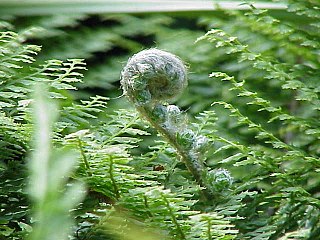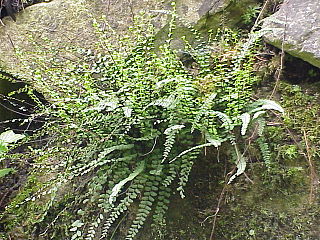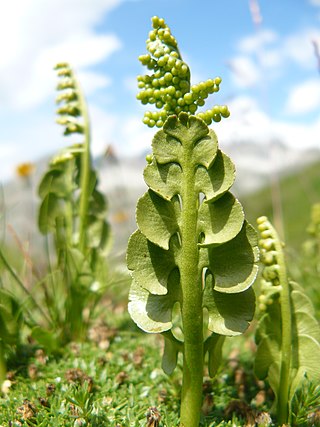
Nephrolepis exaltata, known as the sword fern or Boston fern, is a species of fern in the family Lomariopsidaceae. It is native to the Americas. This evergreen plant can reach as high as 40–90 centimetres (16–35 in), and in extreme cases up to 1.5 metres. It is also known as the Boston sword fern, wild Boston fern, Boston Blue Bell Fern, tuber ladder fern, or fishbone fern.

Polystichum munitum, the western swordfern, is an evergreen perennial fern native to western North America, where it is one of the most abundant ferns in forested areas. It occurs along the Pacific coast from southeastern Alaska to southern California, and also inland east to southeastern British Columbia, northern Idaho and western Montana, with disjunctive populations in northern British Columbia, Canada; the Black Hills in South Dakota, United States; and Guadalupe Island off of Baja California, Mexico. Western swordfern is known to have locally naturalized in parts of Great Britain and Ireland.

Dryopteris expansa, the alpine buckler fern, northern buckler-fern or spreading wood fern, is a species of fern native to cool temperate and subarctic regions of the Northern Hemisphere, south at high altitudes in mountains to Spain and Greece in southern Europe, to Japan in eastern Asia, and to central California in North America. The species was first described from Germany. It prefers cool, moist mixed or evergreen forests and rock crevices on alpine slopes, often growing on rotting logs and tree stumps and rocky slopes. It is characteristically riparian in nature, and is especially associated with stream banks.

Gymnocarpium dryopteris, the western oakfern, common oak fern, oak fern, or northern oak fern, is a deciduous fern of the family Cystopteridaceae. It is widespread across much of North America and Eurasia. It has been found in Canada, the United States, Greenland, China, Japan, Korea, Russia, and most of Europe.

Polystichum is a genus of ferns in the family Dryopteridaceae, subfamily Dryopteridoideae, according to the Pteridophyte Phylogeny Group classification of 2016. The genus has about 500 species and has a cosmopolitan distribution. The highest diversity is in eastern Asia, with about 208 species in China alone; the region from Mexico to Brazil has at least 100 additional species; Africa, North America, and Europe have much lower diversity. Polystichum species are terrestrial or rock-dwelling ferns of warm-temperate and montane-tropical regions. They are often found in disturbed habitats such as road cuts, talus slopes, and stream banks.

Polystichum aculeatum, the hard shield-fern, is an evergreen fern native to Europe. It is most abundant in upland regions of the British Isles and western France, where it benefits from the combination of mild winters and moist summers, but also occurs more locally across most of Europe except northern Scandinavia, northern Russia; in the Mediterranean region it is confined to high altitudes. It grows on steep slopes in woodlands. it is sometimes considered an indicator of the presence of ancient woodlands.

Polystichum setiferum, the soft shield fern, is an evergreen or semi-evergreen fern native to southern and western Europe. The stalks and most midribs are coated with attractive cinnamon-brown scales. The Latin specific epithet setiferum means “with bristles”.

Alsophila capensis, synonym Cyathea capensis, is a regionally widespread and highly variable species of tree fern. It is indigenous to Southern Africa and South America.

Polystichum acrostichoides, commonly denominated Christmas fern, is a perennial, evergreen fern native to eastern North America, from Nova Scotia west to Minnesota and south to Florida and eastern Texas. It is one of the most common ferns in eastern North America, being found in moist and shady habitats in woodlands, stream banks and rocky slopes. The common name derives from the evergreen fronds, which are often still green at Christmas.

Asplenium trichomanes, the maidenhair spleenwort, is a small fern in the spleenwort genus Asplenium. It is a widespread and common species, occurring almost worldwide in a variety of rocky habitats. It is a variable fern with several subspecies.

Botrychium lunaria is a species of fern in the family Ophioglossaceae known by the common name moonwort or common moonwort. It is the most widely distributed moonwort, growing throughout the Northern Hemisphere across Eurasia and from Alaska to Greenland, as well as temperate parts of the Southern Hemisphere.

Rumohra adiantiformis, the leather fern or leatherleaf fern, is a species of fern in the wood fern family Dryopteridaceae. It has a wide distribution, mainly in the tropical Southern Hemisphere.

Amauropelta noveboracensis, the New York fern, is a perennial species of fern found throughout the eastern United States and Canada, from Louisiana to Newfoundland, but most concentrated within Appalachia and the Atlantic Northeast. New York ferns often forms spreading colonies within the forests they inhabit.

Lycopodiella inundata is a species of club moss known by the common names inundated club moss, marsh clubmoss and northern bog club moss. It has a circumpolar and circumboreal distribution, occurring throughout the northern Northern Hemisphere from the Arctic to montane temperate regions in Eurasia and North America. It grows in wet habitat, such as bogs, ponds, moist spots on the tundra, and long-standing borrow pits.

Polystichum aleuticum, the Aleutian holly fern or Aleutian shield fern, is an endangered species of the Polystichum genus and currently consisting of a small, vulnerable population endemic found only on Adak Island, Alaska, a remote island of the Aleutian Islands chain in the northern Pacific Ocean. In 1992, 112 specimens existed in the wild, and a recovery plan was implemented.

Polystichum lemmonii is a species of fern known by the common names Lemmon's holly fern and Shasta fern. It is native to western North America from the Sierra Nevada of California north to Washington. It is also known from British Columbia, where there is a single occurrence in the mountains above the Okanagan Valley.

Polystichum proliferum, commonly known as mother shield fern is an Australian endemic fern. The genus name Polystichum is derived from Greek poly - many, and stichos - rows referring to the many rows of sori. The species name is derived from Latin, Proli – offspring and fer - bearing referring to the proliferous buds, a prominent feature of the species.

Polystichum tsus-simense, commonly known as the Korean rock fern, is a perennial herbaceous plant native to East Asia. Its common name corresponds with its ability to grow in shady areas of rock walls. This fern species is a familiar ornamental plant grown in home gardens.

Dryopteris aemula, the hay-scented buckler-fern or hay-scented fern, is a species of perennial leptosporangiate fern.

Hymenophyllum rarum, the narrow filmy-fern, is a species of fern from the family Hymenophyllaceae. This thin-leaved fern is commonly found in New Zealand and Tasmania, growing in patches on rocks and is epiphytic on trees and tree ferns, growing in moist gullies or rainforests. A rather drought tolerant species often found at exposed sites ranging from coastal to montane areas. Forming extensive, interwoven and creeping patches with its thin long (creeping) rhizomes sparsely covered in red-brown hairs, easily recognised by its membranous grey-green fronds, the smooth margins of the pinnae, ultimate segments and indusia; and by the sunken sori in the uppermost segments of the uppermost pinnae. The species can be found throughout Tasmanian rainforests as well as occurring in New South Wales, Victoria and New Zealand on the North and South Islands as well as, Stewart, Chatham and Auckland Islands.























